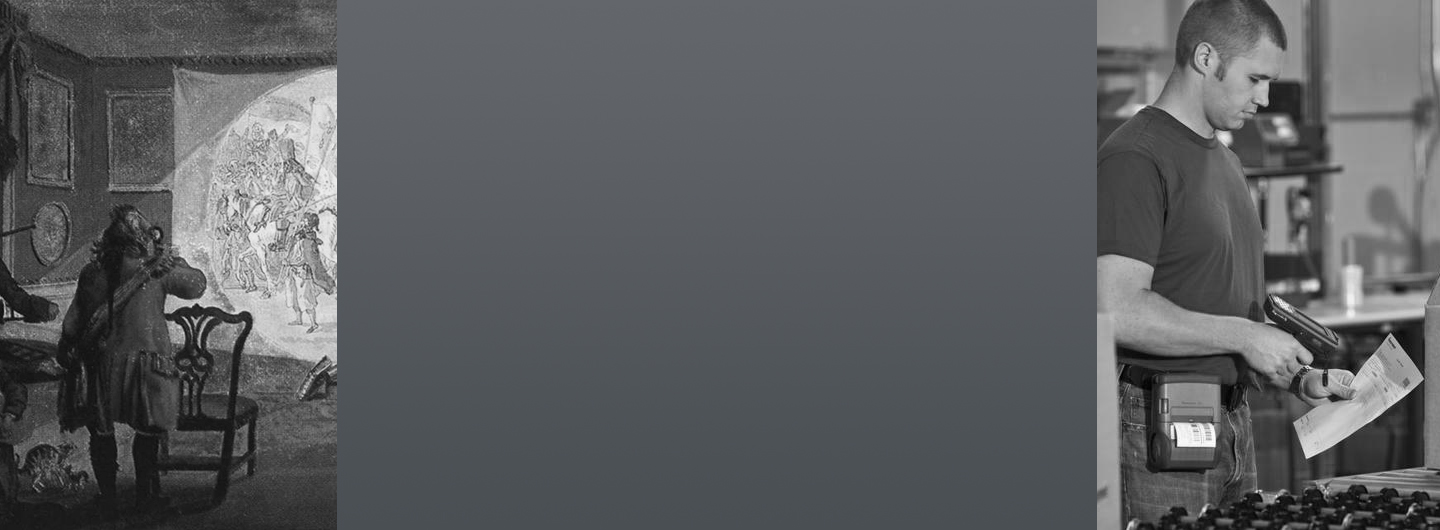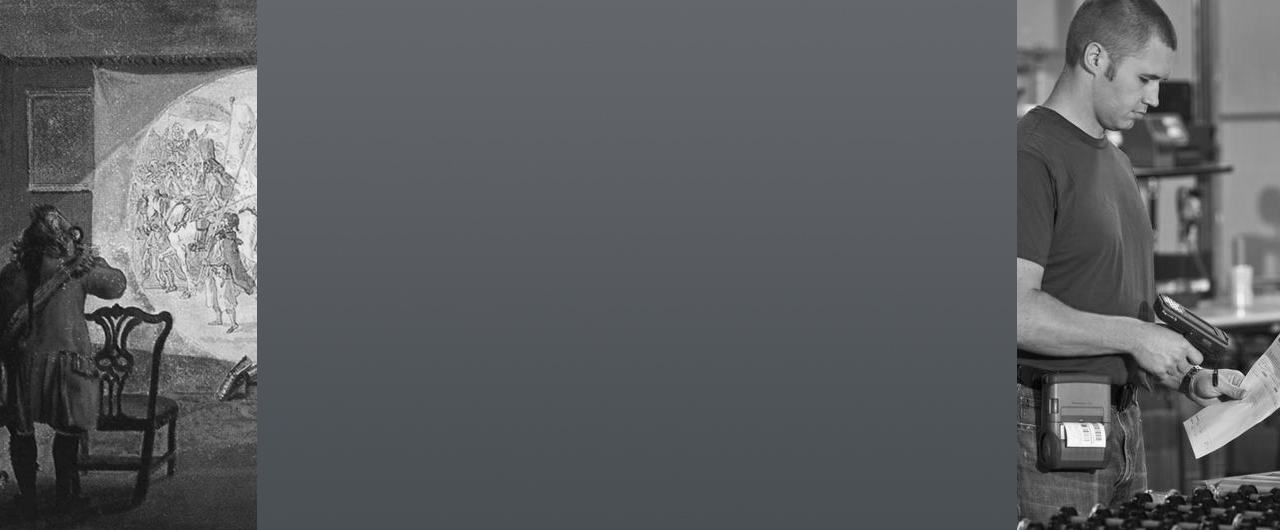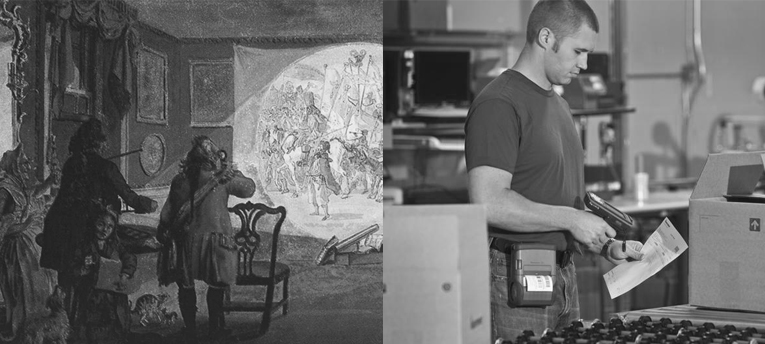





A coating consists of paint, dye, ink or a solid (such as graphite) applied to a substrate like paper or glass. Information is stored by arranging the coating —whether paint on a cave wall or ink in a barcode—in a pattern. The pattern is normally read optically through reflected or transmitted light (although in a few cases the information is read electrically). In many cases it can be read by direct viewing, but the examples included here are intended to be viewed through a lens or read by a device.
This page is organized by the technologies used to apply the coating. Magic lantern slides were originally hand painted. Various forms of printing have been applied to paper, glass and plastic to create slides, vues d'optique, filmstrips, stereoviews and optical toys. Chemical etching and physical carving or scratching have also been used.


For the first two centuries after the invention of the magic lantern, slides were hand-painted on glass. The best professional slides could be stunning, with fine detail and luminous color, but most failed to reach that level— as Sir David Brewster observed: even Michael Angelo would have failed in executing a figure an inch long with transparent varnishes, when all its imperfections were to be magnified.
Amateurs could also try their hand using a kit that supplied paint, blank slides and instructions. A movie theater projectionist might hand-letter an announcement or title slide.
At the other end of the scale, a 1920s movie palace would likely have had an industrial-strength magic lantern like the Brenograph F7 in the projection booth. The large hand-painted disc below would have been placed in a motorized container in the Brenograph and a constantly changing image would be projected onto the screen before the movie started. Similar discs with hand-painted clouds might be placed in a hidden Brenograph Jr." to be projected on the ceiling of atmospheric theatres.
Hand painting has also been used for other removable media, of course, including images for peep boxes and anamorphoses meant to be viewed with a cylindrical or conical mirror.


Even after the adoption of printing technologies for slides and other media, hand coloring played a role until well into the 20th century. For a peep box image, an outline was typically created using intaglio printing or lithography, then filled by an artist using watercolors or oil paint. Outlines for magic lantern slides could be transferred from etched copper plates and then colored by hand. Outlines for early pre-cinema media like phenakistiscope discs were printed, then colored by hand.
Peep boxes, using which viewers saw an image in a box through a lens, were an early form of virtual reality. The box blocked out the real world and gave the showman control over lighting. The lens forced the viewer to look at the picture from the direction for which the perspective was most accurate. The lenses tended to be large, which added a further sensation of depth. Peep box artists and showmen were, in effect, creating a virtual reality experience—one that remained popular from its invention in the 15th century into the 20th.


Tinting consists of applying color by hand or machine to a black and white photograph. Although there were early experiments with color processes soon after photography was invented, practical color photography didn't emerge until the early 20th century. Until then, color was often added by hand using paint or dyes. In the hands of a skilled artist, the result could be beautifully realistic. Tinting was also applied to the back of translucent images to be lit from behind in peep boxes or stereo viewers. Finally, movies were sometimes colored by hand or by applying dyes over stencils hand cut for each frame.


Transfer printing was invented in the 1750s as a way of printing designs on porcelain and other fragile materials. It originally involved etching the design onto a copper plate and printing it to paper, as in a normal intaglio process, then pressing the paper against the procelain and peeling it back to transfer the ink. The technique was first applied to magic lantern slides in 1821 by Philip Carpenter, an English optician. In Carpenter's process, black enamel was applied to the etched copper plate. Then the plate was coated with a layer of glue, which picked up the enamel. The glue layer was removed from the plate and applied to the glass, transferring the enamel to the slide. The slide was then heated in a kiln to bond the enamel permanently. Color was added by hand.
Carpenter's "copper-plate sliders" were a commercial success, although labor intensive. Lithography, invented in 1796, was faster and cheaper and made it practical to print high-quality artwork in quantity, including images on paper for transfer to magic lantern slides. Transferring the ink image to a slide was easy enough for amateurs to do, so much so that in the 1860s it became a huge craze in France and England: "The great rage among the ladies of Paris just at present is 'decalcomanie'", said the Memphis Daily Appeal in July of 1862. The name— decalcomania in English—was shortened eventually to decal. Easier and cheaper than copper-plate printing or hand painting, it became the standard way of printing children's slides.


Intaglio printing emerged in the late 15th century in Europe. In intaglio, the design to be printed is cut into a metal plate using acid or a cutting tool. Ink is applied to the plate, then the plate is wiped, leaving ink in the depressions. The ink is transferred to paper by applying pressure to the plate, which forces the paper into the depressions containing the ink. Intaglio by nature is suited to line art. Shading is typically produced using crosshatching or other patterns of lines. Engraving and etching are both intaglio techniques.
Intaglio was used to produce images on paper for peep boxes and other devices. Prints were often colored by hand with watercolors or dye. Magic lantern slides could also be produced indirectly using intaglio. Pressing the plate directly against the glass slide would transfer little or no ink and break the glass in the process. Instead, intaglio plates were used to create decals for transfer printing (as described above).
In engraving, the design to be printed is stored as grooves cut with a tool into a metal plate. When ink is applied to the plate, it fills the grooves. The remaining ink is wiped off and the plate is pressed against paper, transfering the ink in the grooves.
In etching, a metal plate is coated with wax. The design is scratched through the wax, leaving the metal exposed. When acid is applied to the plate, it etches away the exposed metal. The wax is removed and ink is applied. When the ink is wiped off the plate, it remains in the etched lines. The plate is pressed against paper, transfering the ink and printing the design.
Woodburytype is the only photomechanical printing process that produces continuous-tone prints. The negative is placed against a sheet of photosensitive gelatin that hardens where exposed to light. After placing the negative and gelatin layer in sunlight or UV light, the unhardened gelatin is washed away, leaving the hardened gelatin layer thickest where the light was brightest. The gelatin relief is pressed against a lead plate, creating a negative relief that is then used in a printing press to create a continuous-tone print.


In relief printing the negative space of an image is removed from the printing block, leaving the image as a raised surface. When ink is applied to the block, it adheres only to the raised surfaces. When the inked block is pressed against paper, it leaves the ink corresponding to the raised surface.


Impact printing is a form of relief printing in which metal or plastic type strikes an inked ribbon against a surface, typically paper, thus transferring ink to the surface in the shape of the character. These devices are relatively simple and inexpensive and, before inkjet and laser printers came along, allowed non-professionals to print custom content. Devices include typewriters, teletypes, daisywheel printers and line printers.


In contrast to relief or intaglio, planographic printing uses ink applied to a flat plate. The portions of the plate to receive ink are coated with a water-repelling substance, with the negative space represented by areas that repel ink.
In collotype, the printing plate is coated with sensitized gelatin that hardens when exposed to UV light through a superimposed photographic negative. The gelatin hardens under the light areas of the negative, becoming more receptive to ink. Under dark areas, the gelatin remains soft and rejects ink.
In lithography, the areas of the image to receive ink are given a grease or oil coating. The plate is then treated with an acidic wash, which etches or roughens the negative spaces. Water is applied to the plate. The water is held by the etched areas and repelled by the grease-coated areas. When a oil-based ink is rolled onto the plate, it is repelled by the water coating the etched areas and sticks to the grease-coated areas. The plate is then pressed against the paper or other receiving surface.
In offset lithography the plate is wrapped around a cylinder. Ink and water are applied to the plate cylinder as it spins. The ink is then transferred to a rubber "offset" cylinder and from there to the paper.
In chromolithography, or color lithography, a plate is created for each color to be printed. The color limage is built up by inking and printing the plates in succession.
Halftone lithography is a photomechanical method for printing photographs. The continuous tones of the photograph are represented by dots that vary in size or separation. Color is reproduced by overprinting colors in succession.
Lithography can also be applied to transparent substrates like celluloid film or glassine.


In thermal transfer printing a ribbon holding a waxy ink is pressed against the surface by the printing head. The printing head heats tiny dots in the pattern to be printed, which melt the ink and bond it to the receiving surface. Thermal transfer printing was developed in 1981.


In digital printing there is no printing plate; the image is represented as a digital file and the print is created on-the-fly by applying ink or toner to the medium.
In inkjet printing, tiny droplets of water-based ink are launched from the printer head onto the receiving media using either thermal or piezoelectric technology. Inkjet printers are particularly valued for producing color photographic prints.
In laser printing, an image is transferred to a drum using a laser, building up a pattern of static electricity which then attracts toner (powdered ink). The drum deposits the toner on the receiving media and heat is applied to fix the toner to the media. The media is usually paper, but other kinds of media are available, including transparency film (usually cellulose acetate). Transparencies are typically meant to be projected using an overhead projector.


Ink can be distributed on a surface in meaningful patterns by feeding it through a moving tip or nib. Examples include quill pens, fountain pens and markers. Of course, pen and ink have been used to store information since the ancient Egyptians wrote on papyrus three thousand years ago. Normally that information is extracted through direct visual experience. But pens have also been used to store information specifically meant to be read by machine. The two examples below are for Morse code practice. They use strips of paper on which a simple back and forth pattern is used to the coded message. The machine can play back the code, producing audio dots and dashes that telegraph operators decoded as part of their training. In the case of the McElroy Keyer, used by the military, the pattern is read optically. The Master Teleplex uses a conductive ink that is read electrically.


In photo etching, a pattern is stored as a metal-coating on glass. To create the pattern, the metal is covered with a photosensitive resist. Light is projected onto the surface through a negative of the desired pattern. The photoresist hardens where exposed to light. The unexposed resist is dissolved and the surface is coated with an etching chemical, which removes the metal corresponding to the opaque areas of the pattern, leaving a silhouette of the original. Photo etching is used to create the masks that are central to manufacturing integrated circuits. It's also used to create gobos, which are inserted into stage lighting to project silhouettes.


In scratch-off art, a pattern is created using a tool with a sharp tip to remove parts of a dark coating, revealing the surface underneath. In the case of magic lantern slides, removing the coating leaves transparent glass. When projected, the illustration or diagram appears as white against a black backround. Colors can be added after the fact by over-painting with watercolors, as with the Morropaque slide below.


Tape stuck to a surface with adhesive can function in the same way as more traditional coatings. The item below is a Kartrack bar code for a system used to identify railroad cars in the 1970s. This was the first use of bar codes, which were invented by David J. Collins specifically for this purpose. The colored stripes encoded the car number, car type and owner. The stripes are reflective tape developed by 3M for this application.